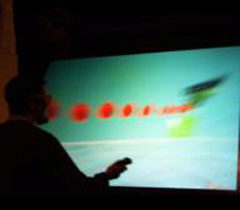EVL: Alive on the Grid
January 1st, 2000 - September 1st, 2001
Categories: Multimedia, Sound Art, VR Art

About
Networking, sound and interaction are all key elements of Dan Sandin’s EVL: Alive on the Grid, a collection of virtual art worlds where local and distant participants alike can interact in shared virtual spaces.
Enabled by the Grid-collections of networks, computers and virtual reality displays that span the globe-users of this unique media can “virtually” interact with one another, and the models contained within each piece. Displayed in a CAVE™ - a four-wall, theater style virtual reality environment - users don lightweight head and hand trackers and access the worlds through a virtual atrium, where they encounter visitors from around Europe and the U.S.
Through their virtual representative, or avatar, users can navigate and interact with others in real time. Each visitor’s avatar, identifiable by a photo-realistic 3D face, is able to create and alter the virtual worlds they visit, leaving “ghosts” of themselves for others to view. All of the worlds are persistent, which means they continue to grow and collect information from remote participants on the Grid even after festival users leave the environment.
All of the CAVE™ pieces were created using Ygdrasil (YG), a system for authoring networked virtual environments developed by Electronic Visualization Laboratory (EVL) Ph.D. graduate Dave Pape. Ygdrasil provides a shared scene graph to automatically connect distributed virtual elements and users, and uses a high-level scripting layer and plug-ins to easily assemble environments from existing components. It is an extensible system, based on EVL’s CAVERNsoft and the commercial software OpenGL Performer. It is available at www.evl.uic.edu/pape/yg/.
Dan Sandin, co-director of Electronic Visualization Laboratory (EVL) at the University of Illinois at Chicago, co-invented the CAVE™ in 1991, and brought it to the Ars Electronica Center when it opened in 1996. Since then, EVL has concentrated on the development and deployment of networked virtual reality, that is, VR worlds that distantly located people can view and change in real time. Sandin curated this collection of networked virtual environments created by students, former students, and faculty of EVL and the following participating sites:
- Electronic Visualization Laboratory, University of Illinois at Chicago
- Interactive Institute - Tools for Creativity Studio, Umea, Sweden
- State University of New York (SUNY), Buffalo
Center for Computational Research and the Department of Media Study - Indiana University
H.R. Hope School of Fine Arts
University Information Technology Services
Advanced Visualization Laboratory - C3 Center for Culture & Communication Foundation, Budapest, Hungary
- V2 Lab / V2 Organization Institute for the Unstable Media, Rotterdam, collaborating with the Technische Universiteit Eindhoven (TU/e) and Stichting Academisch Rekencentrum Amsterdam (SARA), The Netherlands